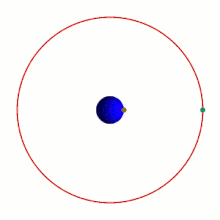Orbit geopegun
Orbit Geopegun (bahasa Inggeris: geostationary orbit) ialah orbit geosegerak yang mengikut arah putaran Bumi pada altitud 35,786 km (22,236 bt) atas khatulistiwa dan mempunyai kesipian orbit menghampiri sifar.


Apa-apa objek dalam orbit geopegun akan kelihatan seakan-akan tidak bergerak oleh pemerhati diatas permukaan Bumi, kerana tempoh orbit objek di mengelilingi Bumi adalah sama dengan tempoh putaran Bumi. Idea satelit geopegun untuk tujuan komunikasi diterbitkan pada tahun 1928 oleh Herman Potočnik dalam tulisanya yang berjudul Das Problem der Befahrung des Weltraums (Masalah Perjalanan Angkasa Lepas).[1] Konsep orbit geopusat kemudian dipopularkan oleh penulis cereka sains, Arthur C. Clarke pada 1940-an sebagai cara untuk merevolusikan sistem telekomunikasi.[2][3] [4]Satelit pertama yang diletakkan pada orbit ini dengan berjaya ialah Syncom 3 yang dilancarkan pada tahun 1964.

Lihat Juga
[sunting | sunting sumber]Rujukan
[sunting | sunting sumber]- ^ Noordung, Hermann (1929). Das Problem der Befahrung des Weltraums: Der Raketen-Motor (PDF). Berlin: Richard Carl Schmidt & Co. m/s. 98–100.
- ^ Arthur C. Clarke (October 1945). "Extraterrestrial Relays: Can Rocket Stations Give World-wide Radio Coverage?" (PDF). Arthur C. Clarke Institute for Space Education. Dicapai pada 1 January 2021.
- ^ "It is therefore quite possible that these stories influenced me subconsciously when ... I worked out the principles of synchronous communications satellites ...", McAleer, Neil (1992). Arthur C. Clarke. Contemporary Books. m/s. 54. ISBN 978-0-809-24324-2.
- ^ "(Korvus's message is sent) to a small, squat building at the outskirts of Northern Landing. It was hurled at the sky. ... It ... arrived at the relay station tired and worn, ... when it reached a space station only five hundred miles above the city of North Landing." Smith, George O. (1976). The Complete Venus Equilateral. New York: Ballantine Books. m/s. 3–4. ISBN 978-0-345-28953-7.
Pautan luar
[sunting | sunting sumber]- Graphical derivation of the geostationary orbit radius for the Earth Diarkibkan 2008-11-20 di Wayback Machine
- ORBITAL MECHANICS (Rocket and Space Technology)
- List of satellites in geostationary orbit
- G · m · t² = 4 · π² · r³. Kepler's 3rd Law. Ultra Calculator. Solves for Mass, Orbital Radius or Time
- Kepler's 3rd Law Calculator. T 2 = R 3
- Clarke Belt Snapshot Calculator Diarkibkan 2006-06-26 di Wayback Machine
- 3D Real Time Satellite Tracking
- http://www.1728.org/kepler3a.htm G · m · t² = 4 · π² · r³,Kepler's 3rd Law, Ultra Calculator
- http://physics.stackexchange.com/questions/48698/what-is-geostationary-orbit-radius
- http://www.schoolphysics.co.uk/age16-19/Mechanics/Gravitation/text/Geostationary_satellite/index.html
